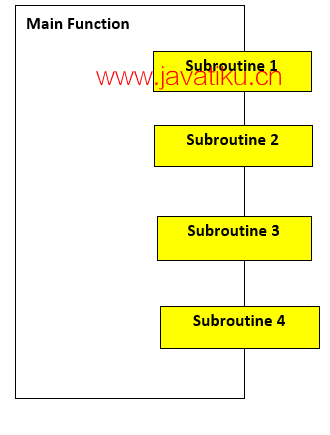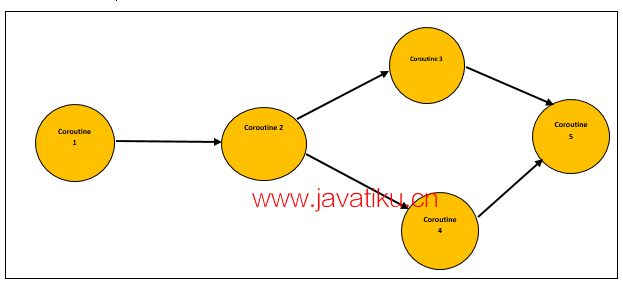Python教程-Python 协程

在本教程中,我们将学习 Python 中的协程。我们将详细讨论协程、子程序、协程的执行以及在 Python 中关闭协程。
在我们开始学习协程之前,我们必须对 Python 中的子程序有基本的了解。因此,我们将从 Python 子程序开始本教程。
Python 子程序
众所周知,在 Python 中有函数,我们可能知道或不知道这些 Python 函数也被称为过程、子过程或子程序。
通常,Python 中的函数是一系列指令的打包序列,它们作为一个单元来执行代码中的某个特定任务。当我们将复杂函数的逻辑划分为几个自包含的步骤,并且这些步骤像一个独立的函数(嵌套函数等)一样工作时,主函数中的这些辅助或嵌套函数被称为 Python 中的子程序。
在 Python 中,子程序是由主函数调用的,主函数在使用函数的同时负责协调它们。Python 中的所有子程序都只有一个入口点,即主函数的开始。
主函数

从上面给出的图中,我们可以轻松得出结论,主函数在使用子程序时是必需的,主函数也是子程序在 Python 中的唯一入口点。
什么是协程?
现在,在这一部分,我们将讨论协程,它们基本上是子程序的一种概括。
协程通常用于进程的协同多任务,即自愿放弃(yield)一段时间(周期性地)控制权。当空闲时,协程也可用于同时运行多个应用程序。

协程不同于线程,因为在协程中,是程序员和编程语言决定何时切换协程,而在线程的情况下,操作系统安排线程之间的切换。
协程与子例程的区别
| 协程 | 子例程 |
|---|---|
| 与子例程不同,协程具有多个入口点。 | 子例程只有一个入口点,即主函数。 |
| 我们只能从Python子例程的单一点挂起和恢复执行,只能从起始点恢复执行。 | 我们可以从Python协程的函数中的多个点挂起和恢复执行,也可以从上次挂起的地方恢复执行。 |
| 与子例程不同,Python协程没有主函数来特别指导和协调它们的执行。 | 在Python子例程中,主函数协调多个子例程之间的执行并控制它们的执行。 |
| 协程是协作的,因为它们在执行时一起形成了一个管道结构。 | 子例程形成线性执行结构。 |
| 在协程中,我们有一个协程来显示输入数据的结果。 | 对于子例程,输入数据中的处理结果由主函数显示。 |
Python中的协程
协程与Python中的生成器非常相似,但协程在yield(放弃)语句和一些附加方法方面有一些修改。Python协程还能够消耗输入数据,而生成器只能在函数中生成数据。
在Python版本高于2.5的情况下,我们可以观察到协程的yield语句发生了细微变化,经过这个变化后,yield语句可以用作表达式。
示例: 将yield分配到右侧,即LineOfCode = (yield)
在程序中发送给协程的任何值都将被协程捕获,并仅通过yield表达式返回。我们只能通过send()函数向协程发送值。
考虑下面的程序中的协程,它将仅打印具有“Officer”前缀的名称,并且我们将使用send()函数将名称发送到协程。
示例:
# Default function to search prefix
def print_name(prfx):
print("Coroutine object searching for the prefix: {}".format(prfx)) # Searching for prefix
while True:
GivenName = (yield)
if prfx in GivenName: # If required prefix match
print(GivenName) # Print given name
CorouteObject = print_name("Officer") # Taking prefix = Officer for coroutine object
# Taking names as input from user
Name1 = input("Enter first name: ")
Name2 = input("Enter second name: ")
Name3 = input("Enter third name: ")
CorouteObject.__next__() # using _next_() method to call coroutine
# sending input data to coroutine with send() method
CorouteObject.send(Name1)
CorouteObject.send(Name2)
CorouteObject.send(Name3) 输出:
Enter first name: Alex
Enter second name: Officer Steve Rogers
Enter third name: Officer Natasha Widow
Coroutine object searching for the prefix: Officer
Officer Steve Rogers
Officer Natasha Widow解释 -
正如我们在上面的程序中所看到的,我们从用户那里输入了三个名称作为输入数据,我们使用send()方法将用户输入数据发送到函数中定义的协程。我们在协程中使用“Officer”关键字来搜索具有“Officer”前缀的名称,并且协程只会打印匹配的名称,正如我们在输出中看到的。
协程的执行
在Python中,协程的执行方式与生成器非常相似。当我们在程序中调用协程时,不会发生任何事情;它只会在以下两种响应中运行:send()和next()函数。
在上面的示例中,我们可以清楚地看到,协程仅在程序中调用_next_()方法后才开始执行。协程被调用后,执行会前进到yield的第一个表达式。
之后,协程的执行暂停,等待要发送给协程对象的值。在第一个值发送给协程对象后,它会检查所需的前缀是否存在,如果存在,对象将打印带前缀的名称。在打印名称后,它将通过一个连续的循环,直到再次遇到name = (yield)表达式。
关闭协程
要关闭协程,我们必须在程序中使用close()函数。当我们关闭协程时,它将生成一个异常,即GeneratorExit异常,我们可以像处理异常一样捕获它。
示例 -
# Default function to search prefix
def print_name(prfx):
print("Coroutine object searching for the prefix: {}".format(prfx)) # Searching for prefix
# Using excption handling by try and except
try:
while True:
GivenName = (yield)
if prfx in GivenName: # If required prefix match
print(GivenName) # Print given name
except GeneratorExit: # Handling GeneratorExit exception
print("Now we have closed the coroutine!!")
CorouteObject = print_name("Officer") # Taking preifx = Officer for coroutine object
CorouteObject.__next__() # using _next_() method
# sending input data to coroutine with send() method
CorouteObject.send("Alexa")
CorouteObject.send("Officer Tony Stark")
CorouteObject.send("Officer Steve Rogers")
# closing the coroutine
CorouteObject.close() 输出:
Coroutine object searching for the prefix: Officer
Officer Tony Stark
Officer Steve Rogers
Now we have closed the coroutine!!我们必须记住,如果在关闭协程后尝试发送值到协程对象,程序将在输出中引发StopIteration异常。
通过链接协程创建管道结构
我们可以使用协程创建管道结构。将多个协程链接在一起后,我们可以使用push()方法通过创建的管道结构传送给定数据。要在程序中使用协程创建管道结构,我们必须注意以下几点:
- 我们必须提供一个初始源,即生产者,它将生成完整的管道结构。通常,生产者本身不是协程,而只是一个简单的方法。
- 我们必须在管道的末端创建一个汇,汇将充当管道的终点。汇是协程管道中的点,可以收集所有输入数据并显示它。
请了解以下带有管道结构的协程程序。
示例:
# Defining producer for the pipeline
def producer(GivenSentence, NextCoroutine):
tokens = GivenSentence.split(" ") # splitting sentence
for token in tokens: # iterating over tokens
NextCoroutine.send(token)
NextCoroutine.close() # closing coroutine
# Defining pattern filter for the pipeline structure
def pattern_filter(SearchPattern = "ing", NextCoroutine = None):
print("In the input sentence, we are searching for words that end with{}".format(SearchPattern)) # Searching for pattern
try:
while True:
token = (yield) # yielding tokens
if SearchPattern in token:
NextCoroutine.send(token) # Sending tokens
except GeneratorExit: # Exception handling for GeneratorExit exception
print("We are done with filtering the given input sentence!!")
# Defining sink for the pipeline
def print_token():
print("I'm sink in the pipeline and I am used to print the tokens given.")
try:
while True:
token = (yield) # yielding tokens
print(token) # printing the tokens from sink
except GeneratorExit:
print("Now we are done with printing!")
# Taking sink variable
PrintToken = print_token()
PrintToken.__next__() # calling sink
# Taking Pattern filter variable
PatternFilter = pattern_filter(NextCoroutine = PrintToken)
PatternFilter.__next__() # calling pattern filter
# Taking a sentence for the producer in the pipeline
GivenSentence = "Steve rogers is running very fast to chase down a train moving with high speed"
producer(GivenSentence, PatternFilter) # calling producer 输出:
I'm sink in the pipeline, and I am used to printing the tokens given.
In the input sentence, we are searching for words that end with ing
running
moving
We are done with filtering the given input sentence!!解释 -
这是我们如何使用多个协程创建管道,并过滤输入数据的方式。过滤或结果数据将在管道的汇点显示,正如我们在上面的输出中看到的。



